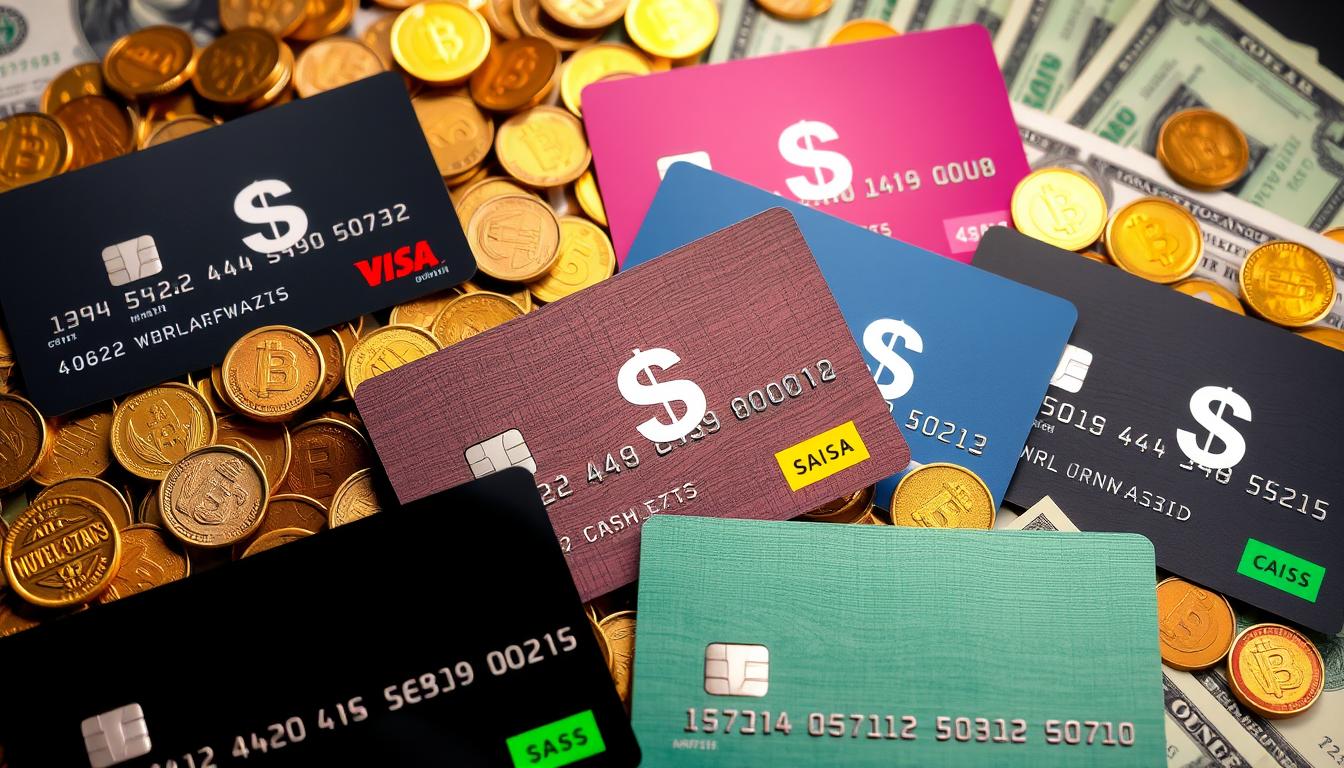The Federal Reserve uses monetary policy to steer the economy. It adjusts the money supply and interest rates. Understanding this policy helps us see its effect on our economic health, inflation, and job levels.

GBTI Visa Gold Card
The Federal Reserve aims for two main goals: high employment and stable prices. This shows how important US monetary policy is in guiding our economy.

Anúncios
Introduction to US Monetary Policy
Monetary policy is how the Federal Reserve controls our nation’s money and affects our economy’s health. It tweaks interest rates, how much banks must keep in reserve, and how easy it is to get credit. This directly changes how much people borrow and spend.
Anúncios
The Federal Reserve’s goal is to keep prices stable and ensure as many people as possible have jobs. It watches things like how fast the economy is growing and how prices are changing. This way, it can adjust its policies to keep the economy growing steadily, tackling both current and future challenges.

Goals of US Monetary Policy
The Federal Reserve aims to keep employment high and prices stable. These goals are part of its dual mandate. This approach helps the economy grow and keeps inflation under control.
Understanding the Dual Mandate
The Fed works hard to boost job growth and stabilize the economy. It looks at unemployment and how many people are working. By doing this, the Fed can change its policies to fit the economy’s needs.
Being flexible is key to keeping the economy strong. It means more jobs for people.
Maximum Employment and Price Stability
The Fed really wants to keep as many people working as possible. This helps everyone and makes the economy better. At the same time, it works to keep prices steady, aiming for 2% inflation.
Managing jobs and inflation well is important. It helps reach the Fed’s long-term economic goals.
How Monetary Policy Works
Monetary policy helps adjust demand for goods and services. It mainly uses interest rates and credit supply changes. If the economy slows, the Federal Reserve may cut interest rates. This encourages people to borrow money and spend more. If the economy gets too strong, raising interest rates helps prevent inflation.
The Federal Open Market Committee (FOMC) makes these decisions. They look at inflation and job data. Then, they set interest rates to match the economy’s needs.
Components of Monetary Policy
It’s key to know the parts of US monetary policy to understand how we keep the economy stable. Interest rates, reserve requirements, and open market operations are these main parts. They all help shape how our economy grows and changes.
Interest Rates and the Federal Funds Rate
Interest rates, especially the federal funds rate, are key in managing the economy. The Federal Open Market Committee (FOMC) sets this rate. It influences what it costs to borrow money across the economy.
When the FOMC changes this rate, it affects how much cash is around. This means people and businesses might spend differently.
Reserve Requirements and Open Market Operations
Reserve requirements are the least banks need to keep on hand. They act as a safety net and affect how much banks can lend. This helps keep banks stable when the economy goes up and down.
Open market operations are about buying and selling government bonds. The Federal Reserve does this to control how much money is in the economy. It helps grow the economy or keep inflation in check.
Expansionary vs Contractionary Monetary Policy
Monetary policy can be split into two types: expansionary and contractionary. During economic slumps or recessions, expansionary policy comes into play. It seeks to boost growth by cutting interest rates, making loans more affordable and hence, boosting spending.
This increase in demand promotes more investment and jobs, aiding in economic recovery. Conversely, contractionary policy aims to cool down an economy that’s too hot, marked by high inflation. It raises interest rates and cuts down the amount of money in circulation.
This method helps manage spending and inflation, slowing growth to achieve balance and keep prices stable. Knowing the effects of these policies is key to understanding their impact on the economy.
Impact of Monetary Policy on Inflation
Monetary policy is key to controlling inflation in an economy. The Federal Reserve sets inflation targets to keep prices stable and promote economic health. Keeping inflation around 2% is crucial for a predictable economy for consumers and businesses. Understanding these methods helps us see how inflation control really works.
The Role of Inflation Targeting
Inflation targeting is vital for guiding the economy and keeping prices stable. By having clear inflation goals, the Federal Reserve tells everyone its plan. This clarity helps people know what to expect about inflation. Knowing these targets makes the economy more predictable, which boosts investment and spending.
Historical Context of Inflation Management
Looking back at inflation management shows how monetary policies have changed. The Federal Reserve has learned a lot from past economic ups and downs. Reviewing high inflation times shows how important it is to act early and effectively to keep the economy stable.
Tools Used by the Federal Reserve
The Federal Reserve uses different tools to carry out its monetary policy. These tools help control how money moves in our economy. They include open market operations, buying assets, and setting the discount rate.
Each one has a key role in making sure there’s enough money and credit available.
Open Market Operations and Asset Purchases
Open market operations are about buying or selling government securities to manage money supply. To boost the economy, the Fed buys assets. This lets banks lend more.
This step encourages people and businesses to spend and invest, driving economic growth.
The Discount Rate and Its Influence
The discount rate is the interest rate banks pay to borrow from the Federal Reserve. If this rate is low, banks are more likely to borrow. This means they can lend more to us, the consumers and businesses.
Changing this rate shows the Fed’s plan for the economy. It helps keep our financial system stable.
Transmission Mechanisms of Monetary Policy
Monetary policy transmission explains how changes in policy, like interest rates, impact the economy. This process is key in understanding the effect of the Federal Reserve’s decisions. Interest rate changes touch different credit channels vital for families and businesses.
When the Federal Open Market Committee changes the federal funds rate, it starts a domino effect in finance. These interest rate shifts directly change bank loan rates, influencing borrowing costs. For instance, when rates drop, loans become cheaper. This encourages consumer spending and business investment.
The three main ways monetary policy works include:
- Interest Rate Channel: Policy rate changes impact borrowing costs for people and companies.
- Credit Availability Channel: Monetary policy tweaks can make banks more or less likely to lend and change how they view borrower creditworthiness.
- Asset Price Channel: Policy changes can affect asset prices, which then influence spending and investment choices.
Understanding these mechanisms helps grasp how monetary policy affects economic conditions, including growth, inflation, and jobs. These channels underscore the importance of timely and precise monetary actions.
Global Influences on US Monetary Policy Dynamics
Global factors deeply impact US economic stability and growth. The Federal Reserve keeps an eye on international events to see how they affect our markets. Things like trade, capital flows, and foreign exchange rates shape US monetary policy.
What happens in other countries can directly change our economy. For example, if our trading partners buy less from us, it affects the Federal Reserve’s plans. It’s critical to understand these ties to predict policy changes and keep our economy strong when the world is uncertain.
Today’s world economies are all connected. This means US policymakers must be ready to adapt quickly. Things like global tensions or financial crises can change our financial system. The US adjusts its monetary policy to handle these changes and protect our economy.
Monetary Policy and Economic Crises
How monetary policy reacts to economic crises shows how finance and rules work together. The 2007-09 crisis showed how the Federal Reserve used different ways to lessen risks and help recovery. It proves that adaptable monetary policy really matters in tough times.
Analysis of the 2007-09 Financial Crisis
In the 2007-09 crisis, the Federal Reserve tried new ways to stop economic downfall. One major move was cutting the federal funds rate to make borrowing cheaper and boost spending. They also used new tools like quantitative easing, buying longer-term securities to put more money in the economy. These steps helped at first, but problems remained after the crisis.
Lessons Learned and Future Projections
The recession taught key lessons for policy makers. One important lesson is that managing liquidity early can better tackle downturns. Keeping financial markets in the loop about policy changes is crucial for stable recoveries too. Looking ahead, focusing on flexible monetary strategies could soften future economic crises, leading to stronger recoveries.
Challenges and Critiques of Current Monetary Policy
Today’s U.S. monetary policy faces many hurdles. Economic analysts are expressing doubts about how effective the Federal Reserve’s actions are. Main concerns include policy delays that affect job numbers and inflation rates.
Many worry about long-term inflation and if current methods will keep prices stable without harming growth. Critics fear low interest rates could lead to too much borrowing and risky investments.
Handling the impact of global economic changes is also tough. As world economies become more connected, outside events can mess with U.S. monetary policy. The Federal Reserve needs to be flexible and creative to deal with these issues effectively.
Conclusion
The Federal Reserve is key in shaping our economy. It uses different tools and strategies to react to economic changes. Its main goal is to keep things stable by balancing growth and managing inflation.
The Fed’s skills in revising its policies matter a lot for future challenges. Learning from past crises and global trends is vital. It follows two main goals: achieving full employment and keeping prices stable.
To support ongoing economic growth, the Fed must be proactive. By monitoring both US and worldwide conditions, it can handle uncertainties better. This enhances our economy’s strength.
FAQ
What is the primary goal of US monetary policy?
How does the Federal Reserve control inflation?
What are the tools used by the Federal Reserve to implement monetary policy?
What is the difference between expansionary and contractionary monetary policy?
How do changes in the federal funds rate affect the economy?
What are the global influences on US monetary policy?
How did the Federal Reserve respond to the 2007-09 financial crisis?
What are the current challenges facing US monetary policy?
Conteúdo criado com auxílio de Inteligência Artificial


